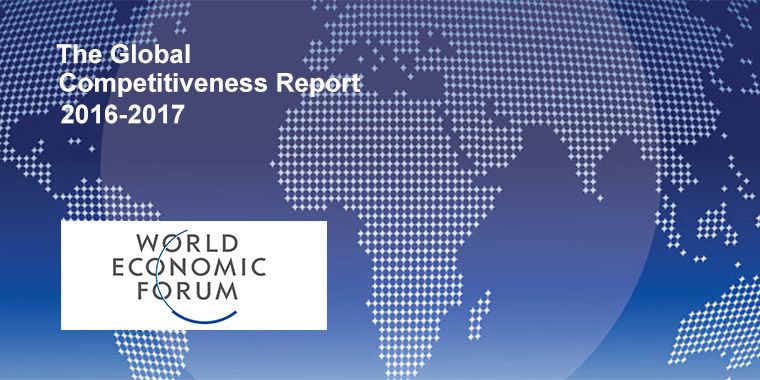Since the recent release of the World Economic Forum’s latest Global Competitiveness Report, investment promotion agencies around the world have been busy updating their marketing materials to either feature the good news on their country score and associated rank as evaluated by this arguably most renowned country competitiveness study, or – in the absence of such good news – feature a reference to some possibly less renown but more benign study instead.
While the top of this year’s ranking is occupied by the usual suspects (Switzerland, Singapore, USA), it features a lot of year-on-year mobility including double digit upgrades (e.g. India/+16, Albania/ +13) and double digit downgrades (e.g. Zambia/-18, Ecuador/-15, Moldova/-16, Cyprus/-18; Macedonia, -12 Philippines, -10). The fact that steep downgrades outnumber steep upgrades seems in line with the common sense perception that competitiveness can often be ruined by a single incident (such as a banking scandal, government change or a natural disaster) but takes a lot of construction work across a number of “pillars” to recover.
“Pillars” is how the WEF dubs 12 aggregate indicators intended to cover the “set of institutions, policies, and factors that determine the level of productivity of an economy, which in turn sets the level of prosperity that the country can achieve”. Although the report stresses that a higher competitiveness score is likely to result in higher GDP growth over time, it doesn’t claim GDP growth (or any other independently measurable data) to function as an empirical test of the statement that a country has become more or less competitive (as compared with an earlier year or with another country). Instead, the index is justified by discussions of the relevance of every single pillar which make up most of the actual annual report.
While debate on what indicators to consider (and how to measure them and aggregate the results) has informed minor adjustments of the framework and respective minor changes in the ranking results in almost every new report, the current GCR has announced and detailed the plan for a methodological disruption that will shake up the ranks in forthcoming reports.
The subject of disruption is a core element of the ranking, the aggregation of sub-indexes resulting in the overall Global Competitive Index. To date, this aggregation is done differently for different groups of countries. Groups are categorized by ranges of per-capita-GDP (with an extra clause accounting for high-per-capita GDP countries heavily dependent on natural resources). The idea behind this differentiation is that productivity enhancers may change as countries move through different stages of economic development. More specifically, the relative weight of meeting basic institutional and infrastructural requirements decreases with growing GDP per capita, while the relative weight of enhancing innovation and business sophistication increases. This is to reflect that increasing productivity in high income countries should benefit more from accelarating technological breakthroughs and stregthening business networks and supply chains in future proof industry sectors than on (further) improving public transportation, health care, education, and macroeconomic stability.
The most striking example of how this weighted approach affects the GCI ranking is the fact that the USA defend their 3rd place despite an embarassing rank 27 regarding said basic institutional and infrastructural requirements. (A less extreme but still significant example is Germany which secures rank 5 despite a 10th rank in meeting basic requirements). Now, one might ask if a country like the USA really couldn’t benefit from taking better care of an institutional, infrastructural and macroeconomical posture that ranks behind Malaysia (26) and hardly better than China (30). Instead of encouraging such questions however, the aggregation logic the WEF used to date implies that basic requirements in high income countries would have to be neglected long enough to turn these countries into low income countries in order to re-gain the relevance that they are granted for those latter countries.
Now, the current report announces to abandon this system of relative weights for forthcoming rankings in favor of a more “leveled” approach that ensures global comparability by applying the same sub-index weights for every country. This decision is being justified mainly by reference to information technologies that are assumed to have made it a lot easier to innovate and form business networks even in the absence of a fully functioning physical an institutional infrastructure. Now of course, this assumed relation might also be part of the reason why some high income countries like the US that the WEF traditionally assumed to “have exhausted their more basic sources of productivity improvement” have not felt the negative impact of actually neglecting rather than exhausting those basic sources. So it might be speculated that insight in the very failure to account for the problem of high income countries neglecting their basic infrastructure might also have contributed to the WEF’s decision to abandon the “weighted approach”.
Ignoring the possible impact of other methodological changes (as well as the possiblity of major performance changes of the countries concerned), it seems safe to predict that the USA will lose their top 3 rank in the next global competitiveness report, while high income countries better at meeting basic requirements than at facilitating innovation and business sophistication (like e.g. Hong Kong, Australia, Slovenia or Iceland) will climb the ranks.
On the other end of the spectrum, low income countries already displaying better capabilites in enhancing innovation and business sophistication (like Costa Rica or Kenya) than in securing their basic infrastructure should reach a better overall score, while low income countries that do perform especially poor on these capabilities (like Cambodia or Nicaragua) should prepare for a drop.
Given the proven influence of the WEF evaluation on the economic policies of many countries, it will be interesting to see if the updated ranking will encourage low income countries to shift resources from improving their basic infrastructure to enhancing innovation business sophistication and countries like the US to consider opposite measures. And if these policy shifts will be successful.
It should be stressed that unless such policy effects kick in, the changed GCI values and ranks resulting from this methododolical change will not reflect any change in the competitiveness of the affected countries as indicated by the 12 single pillars. It should be this latter, detailed evaluation that every stakeholder in the competitiveness of a given country should care for. If the stakeholder however is a potential foreign investor, he might as well be interested in only a selected few of these pillars, while at the same time being heavily reliant on further details relative to his industry, company size, home country, kind of investment planned etc. Since not even the most comprehensive of country competitiveness studies could ever be expected to provide that level of detail, potential investors (and the agencies trying to attract them) will be well advised to view the value of such studies in being but a good starting point for more customized FDI intelligence.





